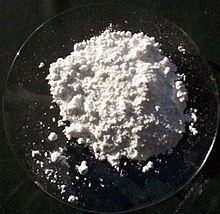بەکارھێنەر:Aram/تاقیکردنەوە
| |||

| |||
| Names | |||
|---|---|---|---|
| IUPAC name
Calcium carbonate
| |||
| Other names | |||
| Identifiers | |||
3D model (JSmol)
|
|||
| ChEBI | |||
| ChEMBL | |||
| ChemSpider | |||
| DrugBank | |||
| EC Number |
| ||
| KEGG | |||
PubChem CID
|
|||
| RTECS number |
| ||
| UNII | |||
| |||
| |||
| Properties | |||
| CaCO3 | |||
| Molar mass | 100.0869 g/mol | ||
| Appearance | Fine white powder; chalky taste | ||
| Odor | odorless | ||
| Density | 2.711 g/cm3 (calcite) 2.83 g/cm3 (aragonite) | ||
| Melting point | ١٬٣٣٩ °C (٢٬٤٤٢ °F; ١٬٦١٢ K) (calcite) ٨٢٥ degrees Celsius (١٬٥١٧ degrees Fahrenheit; ١٬٠٩٨ kelvin) (aragonite)[٤][٥] | ||
| Boiling point | decomposes | ||
| 0.013 g/L (25 °C)[١][٢] | |||
Solubility product (Ksp)
|
3.3×10−9[٣] | ||
| Solubility in dilute acids | soluble | ||
| Acidity (pKa) | 9.0 | ||
| −3.82×10−5 cm3/mol | |||
Refractive index (nD)
|
1.59 | ||
| Structure | |||
| Trigonal | |||
| 32/m | |||
| Thermochemistry | |||
Std molar
entropy (S |
93 J·mol−1·K−1[٦] | ||
Std enthalpy of
formation (ΔfH⦵298) |
−1207 kJ·mol−1[٦] | ||
| Pharmacology | |||
| A02AC01 (WHO) A12AA04 (WHO) | |||
| Hazards | |||
| Safety data sheet | ICSC 1193 | ||
| NFPA 704 (fire diamond) | |||
| Lethal dose or concentration (LD, LC): | |||
LD50 (median dose)
|
6450 mg/kg (oral, rat) | ||
| NIOSH (US health exposure limits): | |||
PEL (Permissible)
|
TWA 15 mg/m3 (total) TWA 5 mg/m3 (resp)[٧] | ||
| Related compounds | |||
Other anions
|
Calcium bicarbonate | ||
Other cations
|
Magnesium carbonate Strontium carbonate Barium carbonate | ||
Related compounds
|
Calcium sulfate | ||
Except where otherwise noted, data are given for materials in their standard state (at 25 °C [77 °F], 100 kPa). | |||
| Infobox references | |||
- ^ SI Chemical Data Book (4th ed.). John Wiley & Sons Australia. 2008. ISBN 978-0-470-81638-7.
- ^ Calcium Carbonate: From the Cretaceous Period Into the 21st Century. Springer Science & Business Media. 2001. ISBN 978-3-7643-6425-0.
- ^ Benjamin، Mark M. (2002). Water Chemistry. McGraw-Hill. ISBN 978-0-07-238390-4.
- ^ «Occupational safety and health guideline for calcium carbonate» (PDF). US Dept. of Health and Human Services. لە 31 March 2011 ھێنراوە.
{{cite web}}: نرخەکانی ڕێکەوت بپشکنە لە:|accessdate=(یارمەتی) - ^ «Archived copy» (PDF). لە ڕەسەنەکە (PDF) لە 29 October 2018 ئەرشیڤ کراوە. لە 29 October 2018 ھێنراوە.
{{cite web}}: نرخەکانی ڕێکەوت بپشکنە لە:|access-date=و|archive-date=(یارمەتی)ڕاگرتنی شێوازی سەرچاوەی ١: archived copy as title (بەستەر) - ^ ئ ا Zumdahl, Steven S. (2009). Chemical Principles 6th Ed. Houghton Mifflin Company. p. A21. ISBN 978-0-618-94690-7.
- ^ NIOSH Pocket Guide to Chemical Hazards. «#0090». National Institute for Occupational Safety and Health (NIOSH).


